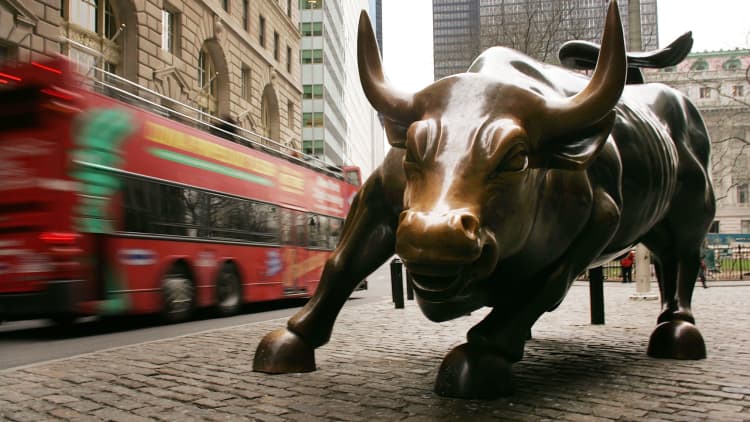
If you've sneaked a peek at your 401(k) plan or IRA account values recently, it was likely a feel-good (or feel much better) experience. The epic 8-year-old bull market has sent the up more than 300 percent from its March 2009 low and plumped up our collective retirement prospects.
Not to be a total killjoy, but the endorphin kick from staring at fatter account balances could also be triggering some dangerous retirement magical thinking.
More than 80 percent of workers recently surveyed by BlackRock expect their retirement account returns will continue to match or exceed the returns of the past.
That's a tall order.
The 19.5 percent annualized rate of return for the S&P 500 during this bull market is already nearly double the 10 percent long-term norm going back to 1926. And even 10 percent is asking too much given where valuations are today and the long odds that there's some magic economic growth potion that can support valuations moving a lot higher. A host of heavy-hitter investment firms, including BlackRock, GMO and AQR are on the record that over the next 10 years returns could be less than half their long-term average.
And bonds aren't going to be able to keep up either.

The yield for basic bonds is a solid predictor of their return potential over the next 10 years. The current 2.5 percent yield for a U.S. bond index is about 2 percentage points less than the annualized return that index has delivered for the past 15 years.
"The biggest problem investors have is an 'expectations gap,' between the returns that they hope to earn, and the plausible returns on today's low-yielding markets," said Rob Arnott, chairman and chief executive officer of Research Affiliates, a thought leader whose strategies are the playbook for more than $165 billion in investment assets.
Research Affiliates churns out 10-year return expectations for a variety of asset classes, adjusted for inflation. The firm expects the S&P 500 will likely deliver just 0.7 percent a year over the next decade, a sharp comedown from the 12.6 percent real return of the past five years. Same story with small caps; the 11.5 percent annualized real return for the Russell 2000 index of small cap stocks for the past five years is expected to shrink to just 0.5 percent over the next 10 years.
Individual investors have plenty of overly optimistic company. BlackRock found that 70 percent of plan sponsors expect returns over the next 10 years to be just as good as the past. Pension plans are also running into an expensive disconnect. A common assumed rate of return for pension plans is 7.5 percent before inflation. Even though plans may use that as their target, they aren't exactly confident they will get there.
Even among the most optimistic of the nearly three-dozen institutional investment firms surveyed by Horizon Actuarial, barely half think a nominal 7.5 percent is likely to materialize.
Pension plans have their reasons for sticking with a too-high assumed rate of return. (Namely, not wanting to have to increase pension contributions and/or report a lower funded status.)
That's not going to work for you. Those meager return estimates can make a mess of your plans. "If we expect the markets to fund our retirement, we'll save too little, spend too much and retire too soon," said Arnott. Framed as advice, it's pretty simple: Save more, spend less and give serious thought to working longer, if need be.
And while it's not wise to expect the markets to do the heavy lifting over the next decade, shifting more of your portfolio to pockets that are not nearly as rich as ours will boost your return potential. (Hint: stocks outside the U.S.)
Finally, curb your enthusiasm for retirement calculators. When Research Affiliates took a spin through a handful of calculators and pension fund expectations, it found that on average the assumed real rate of return is around 5 percent, which is in line with historical norms. But based on its estimates of returns for the next 10 years, Research Affiliates expects a classic 60 percent stocks/40 percent bonds U.S. portfolio will deliver less than 1 percent annualized over the next 10 years. (You can game out the potential return for your current allocation, using RA's free 5 Percent Challenge.)
"Retirement calculators can be such a disservice," said David Blanchett, head of retirement research at Morningstar. "Using the historical averages gives an incomplete picture of expected returns based on current valuations." Especially now.
If you're a 20-something with multiple market cycles ahead of you, that's not necessarily a big deal. If you're nearing retirement, overestimating your return potential for the homestretch can mean you don't get to the finish line when you want, or with all you need.
Blanchett's advice is to ratchet down your expected return "by at least 3 percentage points" from the historical averages and see if that necessitates a rethinking of what you're saving and spending, and perhaps adjust your retirement target date.




